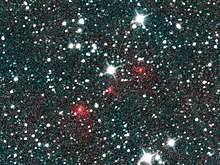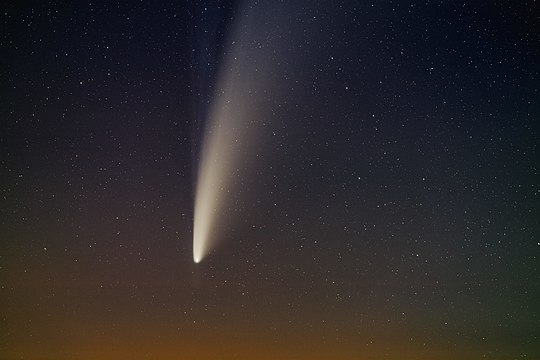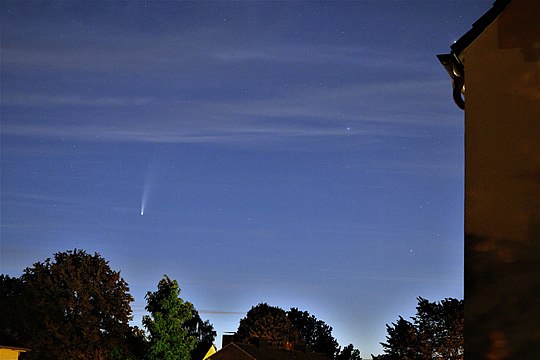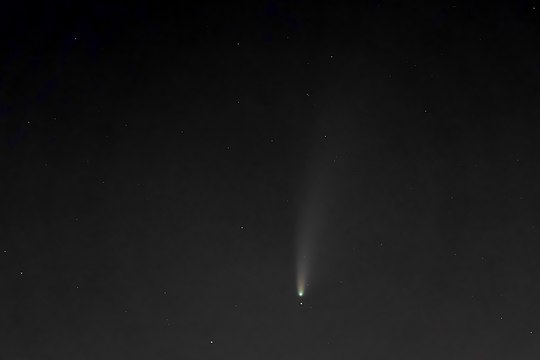C / 2020 F3 (NEOWISE)
| C / 2020 F3 (NEOWISE) [i] | |
|---|---|
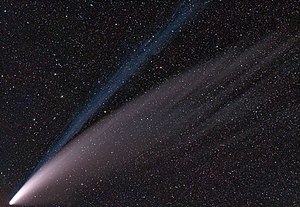
|
|
| C / 2020 F3 (NEOWISE) on July 14, 2020 | |
| Properties of the orbit ( animation ) | |
| Orbit type | long-period |
| Numerical eccentricity | 0.99918 |
| Perihelion | 0.295 AU |
| Aphelion | 722.3 AU |
| Major semi-axis | 361.3 AU |
| Sidereal period | ~ 6868 a |
| Inclination of the orbit plane | 128.9 ° |
| Perihelion | 3rd July 2020 |
| Orbital velocity in the perihelion | 77.6 km / s |
| Physical properties of the core | |
| Medium diameter | ~ 5 km |
| history | |
| Explorer | WISE space telescope |
| Date of discovery | March 27, 2020 |
| Source: Unless otherwise stated, the data comes from JPL Small-Body Database Browser . Please also note the note on comet articles . | |
C / 2020 F3 (NEOWISE) is a comet that could be freely observed in summer 2020 .
Discovery and observation
Comet C / 2020 F3 was discovered on March 27, 2020 as part of the NEOWISE (Near-Earth Object Wide-field Infrared Survey Explorer) project with the aid of the reactivated WISE space telescope in the southern sky , in the constellation Puppis ( aft deck of the ship ). It passed the point of its orbit closest to the sun, the perihelion , on July 3, 2020. In Central Europe , the comet could already be seen with the naked eye at the beginning of July, initially in the morning sky in the northeast, and from around July 10 also in the evening sky in the northwest. In the second half of July it was to be found in the constellation Ursa Maior ( Great Bear ), its closest distance to Earth was on July 23.
NASA estimates the diameter of the comet's nucleus to be around 5 km.
Orbit
An elongated elliptical orbit could be determined for the comet from 781 observation data over a period of 128 days , which is inclined by around 129 ° to the ecliptic . The comet's orbit thus runs strongly against the planets of the planets, and it runs through its orbit relative to these in the opposite sense ( retrograde ). At the point closest to the Sun ( perihelion ), which the comet passed on July 3, 2020, it was about 44.1 million km from the Sun and was within the range of Mercury's orbit . On July 12th it passed Mercury at a distance of about 58.5 million km, and Venus at a distance of about 86.1 million km on July 14th. On July 16, it was closest to Mars at about 174.4 million km, and on July 23, it was closest to Earth at about 103.5 million km (0.69 AU ).
The comet moves in an extremely elongated elliptical orbit around the sun. According to the orbital elements , which are afflicted with a certain uncertainty - and without taking non-gravitational forces into account - its orbit still had an eccentricity of around 0.99891 and a major semi-axis of around 273 AU long before this passage of the inner solar system in 2020 , so that its orbital period was around 4506 years. Thus, the previous passage through the inner solar system could have been around the year 2487 BC. BC (astronomical −2486, uncertainty ± 7 a).
Due to the gravitational pull of the planets, especially with the relatively close passages of Jupiter on September 20, 2020 in about 4 ¼ AU distance and on Saturn on November 8, 2020 in about 9 AU distance, its orbital eccentricity is about 0.99919 and its major semiaxis can be enlarged to about 361 AU, so that the period of revolution increases to about 6860 years. When the celestial body reaches the point furthest from the sun ( aphelion ) of its orbit around the year 5450 , it will be about 108 billion km from the sun, over 720 times as far as the earth and 24 times as far as Neptune . Its orbit speed in aphelion is then only about 0.032 km / s, compared to 77.6 km / s in perihelion in 2020. The next perihelion of the comet will possibly take place around the year 8880 (uncertainty ± 14 a).
- The orbit of comet C / 2020 F3 (NEOWISE)
Animation of the orbit from June to August 2020 ( Earth's orbit shown in blue).
Weekly positions of the comet in front of the starry sky - with a smaller distance from the earth (large yellow circles in July 2020) there are larger changes in position. The slightly curved yellow line represents the ecliptic .
Observations in summer 2020
In chronological order:
- The Comet C / 2020 F3 (NEOWISE)
Video from the orbit of the International Space Station on July 5, 2020. First, the Pleiades open on the right in the picture . On the left in the picture you can see the constellation Fuhrmann (Auriga) with its main star Capella . Below, comet C / 2020 F3 rises on the horizon. Then the Hyades appear on the right with the main star Aldebaran of the constellation Taurus (Taurus) . The bright spot in the Hyades, which together with the Pleiades form the Golden Gate of the Ecliptic , is the planet Venus . The horizontal angle of view is around 50 °.
Telescopic image from the Seine-et-Marne département in France from July 13th around 3am CEST .
In the constellation lynx : July 14th, 1:16 am CEST in Berlin from the Alpine summit of the Marienfelde amusement park at a height of 77 meters. Bottom left the Schöneberg gasometer and the Berlin TV tower bottom right .
In the constellation Lynx: July 16 in Vormholz (Witten)
July 16, 11:46 p.m. CEST in Berlin. The comet had an apparent magnitude of about 2.5 m and was just under 15 ° above the horizon of the northern night sky . The tail goes up to the top of the picture and is 3.5 arc degrees long, the greenish coma is 2 arc minutes in diameter. In the upper right corner is the brightest star around the comet, 27 Lyncis, with an apparent magnitude of 4.8 m .
Conjunction with the star Talitha Borealis (Iota Ursae Majoris, 3.2 m ) in the constellation Great Bear at nautical dusk on July 18, 2020 at 11:28 p.m. CEST at an altitude of 17 ° above the northern horizon of Berlin (image height = 4 °). The distance between the star and the comet was seven minutes of arc. At the lower edge of the picture, somewhat to the left of the center, the southern neighbor star Talitha Australis (Kappa Ursae Majoris or Alkaphrah).
Passage of the comet past the globular cluster Messier 53 on August 6, 2020. The animation shows a period of one hour between 9:53 p.m. CEST and 10:53 p.m. CEST. 30 frames with 120 s exposure.
Web links
- C / 2020 F3 (NEOWISE) - Seiichi Yoshida's Home Page, July 7, 2020 (English)
- C / 2020 F3 (NEOWISE) - AiM - Astronomy and internet in Münster (English)
- Comets in July 2020. In: astronomie.info, Astroinfo Association Langnau am Albis , Switzerland
Individual evidence
- ↑ a b C / 2020 F3 (NEOWISE) in the Small-Body Database of the Jet Propulsion Laboratory (English).
- ^ "Comet NEOWISE Brightens the Night" nasa.gov July 5, 2020
- ↑ A. Vitagliano: SOLEX 12.1. Retrieved July 9, 2020 .
